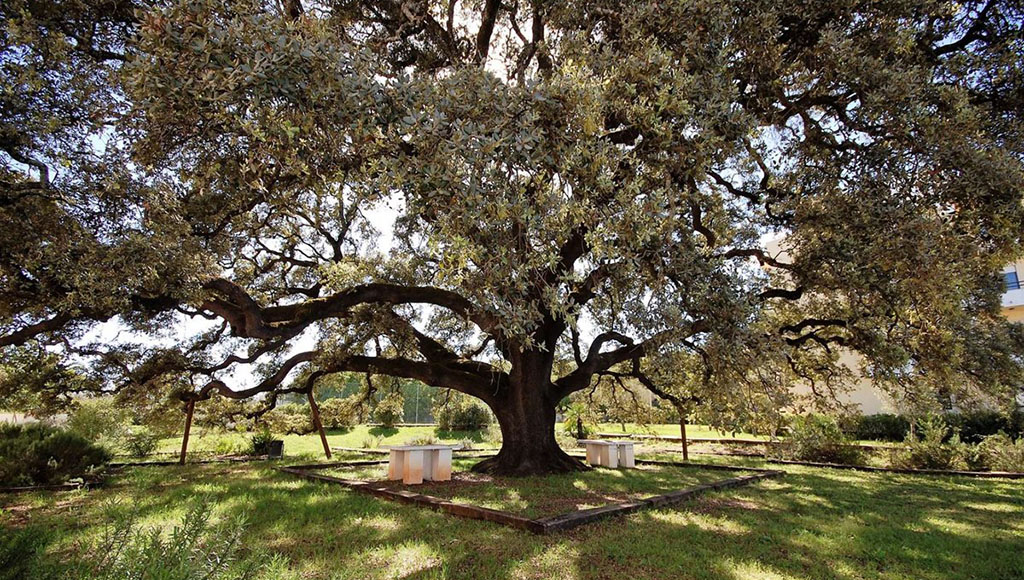“The best time to plant trees was 20 years ago. The next best time to plant trees is today!”
An aristocrat of the woody plant world, oaks are one of the most important genera in the northern hemisphere, with around 435 species, spanning Temperate, Mediterranean, and Tropical biomes.
Oaks are key components of mature woodlands and tall scrubland vegetation in the Iberian Peninsula. A recent taxonomic study proposes a list of 183 oaks recognised in Portugal, 35 native and 148 cultivated. The current oak taxonomy is a ‘never-ending story’, with an entangled nomenclature, inflated by intrinsic natural variation.
Oaks are notoriously susceptible to hybridisation, which can result in viable seeds. The list covers all of Portugal, but there are options for Algarve gardens.
Plant during the winter months, when we hope for rainfall to promote root growth before the heat of summer. Always make generous excavation of a planting hole and avoid compacted soils. The tree should be left with a large shallow bowl in the soil (60cm) around the stem, which will catch rain or irrigation water.
Mulching with organic material or stones (not pine bark) will reduce soil temperature and help retain moisture. Staking is essential in windy locations to prevent damage to developing roots.
Oaks can have shallow root systems so be careful when planting near to established trees.
Quercus canariensis is a rare tree in the Iberian Peninsula whose distribution in Portugal is restricted to the Serra de Monchique and its surrounding area. It is categorised as ‘critically endangered’ because of a continued decline in the size of the national population, now estimated at less than 250 mature individuals, all concentrated in one area.
This continued decline can be attributed to a marked loss of habitat, with the main pressures coming from commercial plantation of eucalyptus, recurrent fires and the expansion of exotic invasive tree species, such as acacias and hackeas.
For its conservation, it is included on the Red List of endangered species in Portugal. The habitat is a special area with humid cooler conditions on neutral to acid soils in the Monchique area.
There is a magnificent example on the EN267 east of Monchique/Alferce. The acorns from this beautiful tree have provided most of the current stock available for sale here. This Monchique tree is considered the country’s purest specimen of an increasingly rare taxon.
Quercus coccifera, also known as Kermes Oak. Although this is commonly seen as a low-growing ground cover, given time, it will form dense shrubs, up to 3m high branching from the base. Drought-tolerant and thrives in many conditions, associated with the larger Quercus rotundifolia as understorey vegetation and there are hybrids between these two species. Single stem examples will form small trees. A reliable spiny-leaved evergreen which provides shelter for wildlife but give it plenty of space to see it at its best.
Quercus rotundifolia holm oak. In evergreen woods and scrubland, often as the dominant species. In dry areas and more prevalent in the interior of the country, ideally suited to Barrocal conditions. A fabulous example of this species can be seen by the side of the N2 in São Brás de Alportel, estimated at 250 years old, 17m high and 5m trunk circumference. You can picnic beneath its shady canopy.
Quercus suber cork oak, the national tree of Portugal. It is dominant in cork oak forests and montados, but also found in other types of woodland and forests throughout the country. Prefers places with some Atlantic influence and with neutral soils, including sandy soils; rarely found on limestone. A long-lived, iconic and beautiful addition to the landscape with excellent resistance to fires and high temperatures. It is not necessary to strip the cork. The oldest and most productive cork oak in the world is the Whistler Tree in Águas de Moura, in the Alentejo. It was planted in 1783, stands over 14 metres tall and the diameter of its trunk is 4.15 metres.
Plant oak trees and forget about the palm or agave weevil, increase biodiversity and add to the good health of our environment. Native trees are the anchors which will go on to build sustainable plant communities supporting bird and insect populations.
They provide cleaner air, shade and better water control. The impact of climate change makes native plants for the garden an obvious choice. Now is a good time to plant trees and leave a long-lasting legacy for future generations.
Links for further information – You can visit and appreciate some of the wonderful monumental trees we have here in the Algarve.
- Trees list of Public Interest http://www2.icnf.pt/portal/ArvoresPesquisa
- Tree Trails, notable ancient trees of the Algarve https://www.monumentaltrees.com/en/prt/algarve/
https://viaalgarviana.org/en/627/monumental-trees-route-monchique
- Info on individual protected trees http://dias-com-arvores.blogspot.pt/
- Garden under oaks https://mediterraneangardening.fr/jocelyns-garden-in-the-gard-2/
- Quercus – native species https://flora-on.pt/#/1quercus
- A new annotated checklist of the Portuguese oaks https://revistas.ucm.es/index.php/MBOT/article/view/79286
By Rosie Peddle
|| features@algarveresident.com
289 791 869 | mgapsec@gmail.com
facebook.com/MedGardenersPortugal
www.mgaportugal.org




















